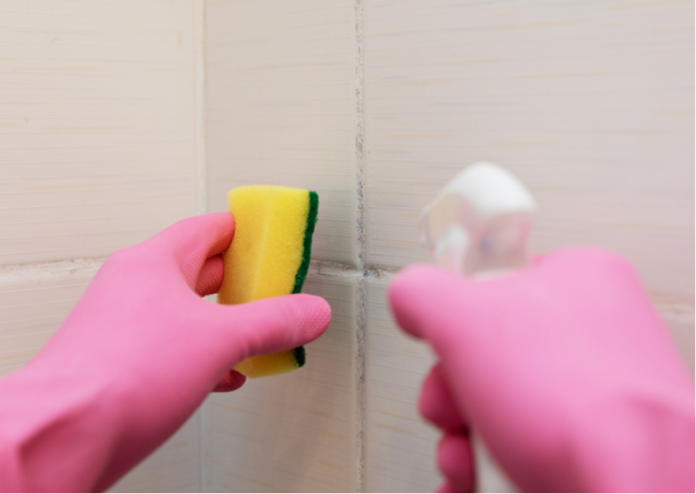Cleaning shower tiles with vinegar and baking soda offers a natural, effective, and eco-friendly tile cleaning solution. The combination of these two ingredients provides a powerful cleaning duo that can tackle tough stains, grime, and soap scum. Their non-toxic nature, versatility, and affordability make them appealing choices for maintaining sparkling new shower or bathroom tiles.
Understanding the Cleaning Power Duo:
When it comes to natural tile bathroom tile cleaning products, vinegar and baking soda are a dynamic duo for tile and grout cleaning. Vinegar, particularly white vinegar, is renowned for its acidic properties. Its high acidity level makes it effective at dissolving mineral deposits, soap scum, and grime. Baking soda, also known as sodium bicarbonate, is a mild abrasive with excellent deodorising properties. It acts as a gentle scouring agent, helping to remove stains and dirt without scratching the tiles.
What makes this combination even more remarkable is how vinegar and baking soda work together. When vinegar and baking soda are combined, a chemical reaction occurs. Bubbles and fizzing are generated, which can help dislodge stubborn stains and grime from the shower tiles. This chemical reaction enhances the cleaning power of both ingredients, making them even more effective in removing dirt and restoring your bathroom tiles’ shine.
Preparing Your Cleaning Solution:
Before you embark on cleaning your shower tiles with vinegar and baking soda, it’s essential to prepare the right cleaning solution. The following instructions will guide you on how to create a powerful and effective Vinegar and baking soda mixture for tile cleaning:
1. Mixing Ratios: Start by combining equal parts of white vinegar and baking soda. For a small area, such as a shower stall, half a cup of each ingredient should be sufficient. For larger areas, adjust the quantities accordingly.
2. Optional Ingredients: While vinegar and baking soda alone are effective, you can enhance the cleaning solution by adding a few optional ingredients like oils and dish soap. For a pleasant fragrance, consider incorporating a few drops of essential oils such as lavender or lemon. Alternatively, you can add a small amount of dish soap for increased cleaning power. However, remember that a little goes a long way, so use these optional ingredients sparingly.
3. Mixing Instructions: To create the cleaning solution, start by pouring the vinegar into a spray bottle or a bowl. Gradually add the baking soda while stirring gently. Be prepared for some fizzing and bubbling as the ingredients react. Once mixed, transfer the solution to a spray bottle for easy application.
It’s worth noting that this cleaning solution should be used immediately after preparation to maximise its effectiveness. Over time, the reaction between vinegar and baking soda will weaken, reducing its cleaning power.
Step-by-Step Guide to Cleaning Shower Tiles:
Now that you have your cleaning solution ready, let’s dive into the step-by-step process of cleaning your shower tiles using vinegar and baking soda:
1. Preparing the Shower Area: Before you begin cleaning, remove any personal items such as shampoo bottles, soap dishes, or loofahs from the shower area. Clearing the space will allow you to clean the bathroom tiles more effectively. Additionally, ensure proper ventilation by opening a window or turning on the exhaust fan to minimise the buildup of fumes.
2. Wetting the Tiles: Thoroughly wet the shower tiles and grout with warm water. This step helps to loosen surface dirt and prepares the tiles for the cleaning solution.
3. Applying the Cleaning Solution: Spray or apply the vinegar and baking soda mixture directly onto the bathroom tiles and grout, focusing on stained or dirty areas. The solution should be evenly distributed to ensure effective cleaning. The acidic nature of vinegar combined with the abrasive properties of baking soda will start working on dissolving stains and grime.
4. Scrubbing: Grab a brush or a sponge and begin scrubbing the tiles and grout. Apply gentle pressure and focus on areas with tough stains or soap scum. The mild abrasiveness of baking soda helps to lift and remove dirt, while the vinegar aids in breaking down mineral deposits. For hard-to-reach areas, use an old toothbrush or a small brush to ensure thorough cleaning. This will aid in removing grime from shower tiles efficiently.
5. Letting it Sit: Allow the cleaning solution to sit on the bathroom tiles and grout for a few minutes. This dwell time allows the vinegar and baking soda to penetrate deeper into the stains, making it easier to remove them. During this time, you may notice some fizzing and bubbling as the solution continues to work its magic.
6. Rinsing and Wiping: Once the dwell time is complete, thoroughly rinse the tiles and grout with clean water. Ensure that all the cleaning solution is completely removed. Use a clean cloth or sponge to wipe away any excess moisture and dry the tiles. This step helps prevent water spots and streaks, leaving your shower tiles looking clean and shiny.
By following these steps, you can effectively clean your shower tiles using vinegar and baking soda. The combination of their natural cleaning properties and the step-by-step approach ensures that your tiles are left fresh and free from stubborn stains.
Dealing with Stubborn Stains and Mould:
While vinegar and baking soda are effective in removing most stains, some stubborn stains and mould may require additional attention. Here are targeted tips for addressing specific cleaning challenges:
1. Soap Scum: Soap scum can build up over time, leaving a dull residue on your shower tiles. To tackle soap scum, create a paste by mixing baking soda with a small amount of water. Apply the paste to the affected areas and let it sit for about 15 minutes. Then, scrub gently with a brush or sponge and rinse thoroughly.
2. Hard Water Stains: Hard water stains can leave unsightly mineral deposits on your shower tiles. To remove these stains, soak a cloth or sponge in vinegar and place it directly on the affected areas. Let it sit for 30 minutes to an hour, allowing the vinegar’s acidity to break down the mineral deposits. Afterward, scrub the stains with a brush or sponge and rinse well.
3. Mould and Mildew: Mould and mildew thrive in damp environments like showers. To combat mould, make a mixture of equal parts vinegar and water in a spray bottle. Spray the solution directly onto the mouldy areas and let it sit for at least 30 minutes. Then, scrub the mould using a brush or sponge, and rinse thoroughly. Vinegar’s natural antifungal properties help eliminate mould and prevent its regrowth.
Remember, for particularly stubborn stains or extensive mould growth, it may be necessary to repeat the cleaning process or consider alternative measures. Always ensure proper ventilation while cleaning, and consider using gloves and protective eyewear when dealing with mould.
Maintenance and Preventive Tips:
Regular maintenance is key to keeping your shower tiles clean and preventing the buildup of tough stains. Here are some practical tips to maintain the cleanliness of your shower tiles:
1. Establish a Cleaning Schedule: Set a regular cleaning schedule to prevent dirt and grime from accumulating. Aim to clean your shower tiles at least once a week or as needed, depending on your usage.
2. Daily Maintenance: After each shower, squeeze the tiles to remove excess water and minimise the chances of water spots and soap scum formation. Wiping down the tiles with a clean cloth or towel can also help maintain their cleanliness.
3. Ventilation: Proper ventilation is crucial in preventing mould growth. Keep your bathroom well-ventilated by using an exhaust fan or opening windows during and after showers. This will help reduce moisture and create an environment less conducive to mould and mildew.
4. Dry Wet Areas: Pay attention to areas prone to moisture, such as corners, grout lines, and shower shelves. After each use, dry these areas with a towel or cloth to prevent mould and mildew growth.
5. Use a Shower Spray: Consider using a homemade shower spray between cleanings to minimise soap scum and mineral deposits. Mix equal parts water and vinegar in a spray bottle and lightly mist the shower tiles after each use. This will help maintain their cleanliness and reduce the need for frequent deep cleaning.
6. Avoid Harsh Cleaners: To protect the integrity of your tiles and grout, avoid using harsh chemical cleaners that can cause damage or discoloration. Stick to natural cleaning methods, such as vinegar and baking soda, which are safe and gentle on most tile surfaces.
By following these maintenance and preventive tips, you can ensure that your shower tiles remain clean and free from stubborn stains or mould growth. Consistency and regular care will help preserve the beauty and longevity of your tiles, keeping your shower a fresh and inviting space.
Benefits of Cleaning with Vinegar and Baking Soda:
Non toxic: Cleaning shower tiles with vinegar and baking soda solution offers several advantages. These ingredients are non-toxic and safe to use around your family and pets. Unlike many commercial tile cleaning products that contain harsh chemicals, vinegar and baking soda solution are natural alternatives that minimise exposure to potentially harmful substances.
Handy option: Vinegar and baking soda solution is incredibly versatile. They can be used to clean various surfaces in your home, not just shower tiles. From countertops and sinks to floors and appliances, these ingredients are effective multitaskers that simplify your cleaning routine.
Anit-bacterial properties: Vinegar has disinfecting properties, making it an excellent choice for eliminating bacteria and germs that may be present on shower tiles. This natural disinfectant is particularly beneficial for households with individuals who have allergies or sensitivities to harsh chemical cleaners.
Cost-effective: Vinegar and baking soda solutions are cost-effective options for cleaning shower tiles. Hence, it is the best natural remedy for cleaning shower tiles. Compared to purchasing specialised bathroom tile cleaners, these household items are budget-friendly and readily available in most kitchens. You can save money without compromising the cleanliness and freshness of your shower tiles.
FAQs:
1. Can vinegar and baking soda damage shower tiles or grout?
You can use vinegar and baking soda as tile cleaner and they are generally safe to use on most shower tiles and grout. However, it’s essential to test the solution in an inconspicuous area or consult the manufacturer’s recommendations if you have any concerns about compatibility. Avoid using vinegar and baking soda on natural stone tiles, as the acidity of vinegar can potentially harm the surface. Additionally, excessive scrubbing or using abrasive tools may cause damage, so it’s important to use gentle techniques.
2. How often should I clean my shower tiles with vinegar and baking soda?
The frequency of cleaning your shower tiles with vinegar and baking soda depends on various factors, such as the level of usage, water quality, and personal preferences. As a general guideline, cleaning your shower tiles with this method once a week or as needed should help maintain their cleanliness and prevent the buildup of stains. Adjust the frequency based on your specific circumstances.
3. Can I mix vinegar and baking soda solution with other cleaning products?
While vinegar and baking soda can be powerful cleaning agents on their own, it’s generally not recommended to mix them with other cleaning products. Combining different cleaning agents may lead to chemical reactions or produce harmful fumes. It’s best to stick to using vinegar and baking soda separately or in combination with optional ingredients mentioned earlier, such as essential oils or a small amount of dish soap.
4. Will vinegar and baking soda eliminate the need for scrubbing?
Vinegar and baking soda can significantly aid in loosening dirt, grime, and stains on shower tiles. The chemical reaction between them helps break down deposits and makes scrubbing easier. However, for stubborn stains or deeply ingrained dirt, some level of scrubbing may still be necessary. Use a brush or sponge to gently scrub the tiles and grout to achieve optimal results.
5. Can I use vinegar and baking soda on coloured or painted shower tiles?
It’s crucial to exercise caution when using vinegar and baking soda on coloured or painted shower tiles. The acidic nature of vinegar can potentially affect the colour or finish of the tiles or paint. It’s advisable to test the cleaning solution in an inconspicuous area first or consult the manufacturer’s recommendations to ensure compatibility with your specific tiles.
Keeping shower tiles clean can be a common challenge for many homeowners. The accumulation of soap scum, hard water stains, and grime can make the bathroom tiles lose their lustre and create an unsightly appearance. Vinegar and baking soda hold remarkable cleaning capabilities, allowing them to effortlessly combat stubborn stains. Also, these are eco-friendly solutions for cleaning, ensuring your safety and preserving the well-being of our planet.
By following the step-by-step guide, preparing the appropriate cleaning solution, and addressing stubborn stains or mould, you can achieve impressive results. Additionally, adopting regular maintenance practices and preventive measures will help keep your shower tiles clean and prevent the buildup of tough stains or mould growth.
So, give vinegar and baking soda a try as your shower tile cleaning products and enjoy the benefits of a fresh, inviting shower space. Embrace the power of nature and the simplicity of these natural cleaning agents for sparkling, beautiful shower tiles.














